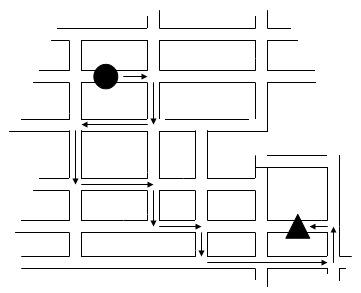Test your concentration and mental self-rotation skills with this quick brainteaser

What is mental self-rotation?
It is the cognitive skill to imagine yourself in different locations in space and to imagine yourself moving accordingly. We need that skill in everyday activities such as reading a map or finding our car in the parking lot.
- Ability involved: egocentric spatial transformations (yes, that is the scientific expression) or mental self-rotation.
- Brain structure involved: mostly parietal lobes.
Let’s take an example.
Imagine that you plan to go to a new Whole Foods store. You wonder whether going North on Big Bend Avenue you would have to make a right or a left turn onto Forsyth Blvd to get to Whole Foods. You then look at the map that your spouse has laid out on the table. It turns out that the map is upside down so your perspective is not aligned with the one shown on the map (see Figure 1 below, box A). How do you get the answer to your question?

–Figure 1
The map is upside down (A). The red dot represents your car’s position. Your goal is to go to Whole Foods (W). You can either perform an object rotation (B), that is imagine the map rotating, or a self rotation ©, that is imagine yourself at the red dot location.
To align your perspective with the one showed on the map, you could imagine the map rotating until it is upright. This is shown at the top right corner of Figure 1 above (Box B). This is what psychologists call mental rotation of object. Another solution, which requires a higher degree of concentration, is to imagine viewing the map from the other side of the table. This is shown at the bottom right corner of Figure 1 above (Box C). Once you have imagined yourself on the other side of the table you can use your body coordinates and determine that you will have to take a left on Forsyth. In that case, the map is not moving but you are moving. This is what psychologists call mental self-rotation.
Ready to imagine yourself moving in space?
For each map below count how many left and right turns you have to make to go from the Circle to the Triangle. Follow the arrows. Do not move your body or your hands, try to do everything mentally.



Solutions
Map 1: 3 left runs and 3 right turns
Map 2: 3 left runs and 3 right turns
Map 3: 6 left runs and 4 right turns

Pascale Michelon, PhD is a scientist, educator, and contributing author to The SharpBrains Guide to Brain Fitness: How to Optimize Brain Health and Performance at Any Age.
–> For more fun cognitive stimulation, you may well enjoy these Top 25 Brain Teasers


